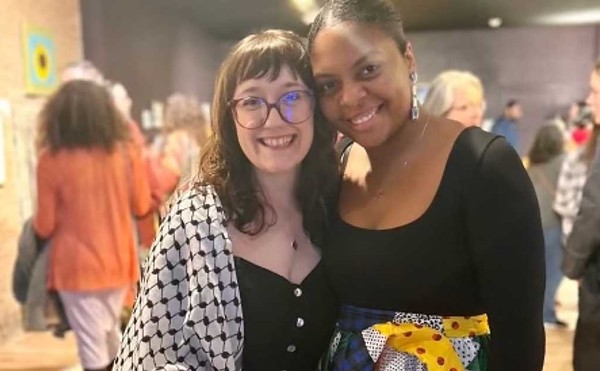Until this latest exhibition of laser-hot paintings at Lemberg Gallery, Beverly Fishman had primarily explored the dehumanizing and invasive procedures, products and ideology of modern medicine. Her graphics referenced the scary imagery of medical technology, such as micrographs and electrocardiograms. Without ever spelling it out, Fishman cast the medical establishment as an indifferent but ever-present force that insinuates itself into our everyday lives with corporate advertising campaigns and logos on gadgets and pharmaceuticals.
Early on, Fishman presented images of microscopic cell life that looked like macrocosmic or astronomical imagery. Later, she left the flat surface of painting to present her take on mass-produced, slick-looking pharmaceutical pills. As Warhol co-opted Brillo boxes, she made larger-than-life fluorescent colored pills, such as Valium, from cast resin. Her pills were delightfully kitschy, but their ecstatic glow also made them appear sinister. Distancing herself even more from the hands-on process of art making, she introduced industrially colored, powder-coated aluminum panels, with an expressionistic mix of medical graphics, composed of vividly colorful, computer-cut vinyl strips. The effect was like an avant-garde musical score or a slick skateboard graphic.
In her sublime paintings at Lemberg Gallery, called Chromophilia (defined as an abnormal love of color), Fishman seems to have pushed her obsession with the human body and medical science further to comment on our environment. Using computer-cut vinyl as expressively as paint, and adding silk-screened moiré patterns to the two-dimensional wall works, she's constructed a manic graphing of our overexposed, high-speed urban landscape. Her new horizontally striped paintings read like symbolic flags of rogue cyber-states.
Fishman's cathode-ray-tube vision assaults and beguiles the brain and eyes with a barcode of colors that seem wrought not only from an intuitive play with the color spectrum, but appropriated from everyday life. High frequency colors — like stop-sign red, traffic-cone orange and luminescent fire-truck yellow, as well as a full spectrum of fluorescence — jostle against each other and vibrate. These works elicit a new range of emotions and effects, from ecstasy to overdose.
In addition to the baroque optical fun in Chromophilia, there is a new sense of architecture and narrative. "Dividose: Red Yellow Blue," the large centerpiece of the exhibition, suggests a post-digital urban landscape. Her color explorations call to mind a computer circuit board, with the foreground modulated in moody blue and red shadows. It's romantically appealing, like a distant nighttime view of the city. But in the same painting, a hyper fluorescent orange and yellow "sunset" sits over the landscape, as a reminder once again, not of nature, but of everything in our increasingly synthetic technoculture, from cell phones to iPods. The paintings, quite literally, blur the boundaries of perception while making statements about our hyperstimulated culture. The abundance of colors and patterns is like a metaphor for technological overload in our world of multimedia saturation, digital maps of an urban grid and DNA code.
A few doors north and upstairs from the Lemberg Gallery, at the Paul Kotula Project, David Schutter's exhibition of Haarlem, from the Northwestern Dunes, from his group of "Afterpaintings: Recollected Paintings from the Gemäldegalerie Berlin," provides a stunning contrast to Fishman's.
Schutter's three small paintings and seven drawings are the result of a heady project to investigate the phenomenology, or essence and effect, of an older world, the art of Dutch realist paintings of the 17th century. For a year at Berlin's Gemäldegalerie museum, he studied realist masterpieces by Vermeer, Rubens, ter Borch, Hals, van Ruisdael and Rembrandt. Schutter repaints these works in search of what makes a masterpiece and to test his own memory and sense of perception.
Schutter's three "afterpaintings" of Jacob van Ruisdael's "Haarlem, from the Northwestern Dunes" are each modest declarations of his own masterly work. Schutter's manner resembles grisaille, a method of painting that uses only shades of gray, but he actually uses a full spectrum color palette that blends into a delicate palette of gray with faint suggestions of color shimmering through the silvery surface. Painting, for him, became an act of memory. After spending some concentrated time with Schutter's works, their subtle differences emerge.
They stand alone as a beautiful collection of marks on canvas. Each painting was accomplished with only his study drawings to aid him in recalling what he saw. In his take on one of van Ruisdael's paintings, a majestic arched cloudscape illuminates the landscape. Schutter's intervening memories of the painting, his drawings and afterpaintings, compel us to seek out and compare them to the original, testing the limits of our own perception.
Like listening to a masterful musical composition where the audience is enveloped and sensitized by gorgeous riffs and repetitions, Schutter's own interpretations teach the viewer to see better. His graceful skill in handling the thin surface of paint is a counterpart to a composer's handling of note and musical phrase. His sensitivity to light and shade as compositional elements varies slightly in each piece, but only as his mind and hand wander, seeking van Ruisdael's painting in his memory.
Both these artists return to earlier roots of painting. Fishman's combustive combinations of color recall the optical paintings of Bridget Riley, among others, and Andy Warhol's pop art. But she resuscitates them, putting a more human spin on past experiments. Schutter's paintings are a fascinating project to translate the mysterious properties of classical composition into a modernist mind-set. The chance meeting of these two artists showing at Ferndale galleries on the same block is an opportunity to see two rigorously wrought contemporary projects by two profound artists.
Beverly Fishman: Chromophilia runs through Saturday, Dec. 2, at Lemberg Gallery, 23241 Woodward Ave., Ferndale; 248-591-6623. David Schutter: Haarlem from the Northwestern Dunes also runs through Dec. 2 at Paul Kotula Projects, 23255 Woodward Ave., Ferndale; 248-544-3020. Beverly Fishman and writer Lynn Crawford will hold a discussion at 7 p.m., Thursday, Nov. 30, at Lemberg Gallery.
Glen Mannisto writes about art for Metro Times. Send comments to [email protected]




